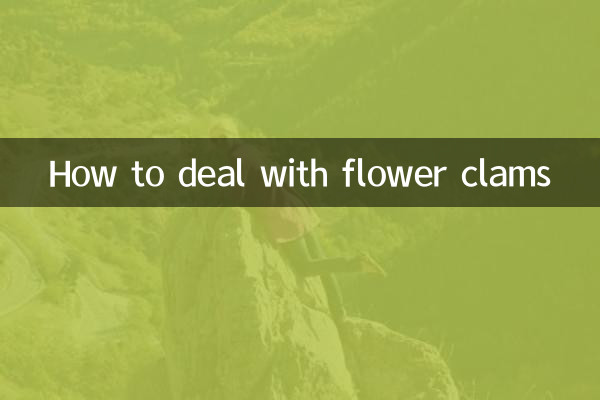How to deal with flower clams
Clam is a common shellfish and is loved for its delicious meat and rich nutrition. However, many people often encounter some problems when handling flower clams, such as how to clean, remove sand, cook, etc. This article will combine the hot topics and hot content on the Internet in the past 10 days to introduce the processing method of flower clams in detail and provide structured data for reference.
1. Cleaning and removing sand from flower clams

Clams live in mud and sand, and sand will inevitably remain in their bodies. Therefore, they must be thoroughly washed and sand removed before cooking. The following are common processing methods:
| steps | How to operate | Things to note |
|---|---|---|
| 1. Preliminary cleaning | Put the flower clams into clean water and scrub the shell with your hands to remove surface sediment. | Avoid using excessive force to avoid damaging the casing. |
| 2. Soak to remove sand | Put the flower clams into light salt water (the ratio of salt to water is 1:50) and soak for 2-3 hours. | The water temperature should not be too high, otherwise the flower clams will die. |
| 3. Change water and spit out sand | Change the water every 30 minutes until the water is clear and free of sand. | Stir gently when changing the water to help the clams spit out sand. |
2. How to cook clams
There are many ways to cook clams, and you can choose different methods according to your personal taste. Here are a few common cooking methods:
| cooking method | specific steps | Features |
|---|---|---|
| steamed | Place the flower clams on a plate, add ginger slices and scallions, and steam for 5-8 minutes. | Authentic flavor, fresh and tender meat. |
| stir-fry | Heat oil and sauté minced garlic and chili until fragrant, add clams and stir-fry until they open, season to taste. | Spicy and delicious, suitable for heavy flavors. |
| Make soup | Boil clams with winter melon, tofu and other ingredients into soup, season with seasoning and serve. | The soup is delicious and nutritious. |
3. Nutritional value of clams
Flower clams are not only delicious, but also rich in many nutrients. The following is the main nutritional composition of clams:
| Nutritional information | Content (per 100g) | Efficacy |
|---|---|---|
| protein | 10.2 grams | Enhance immunity and promote muscle growth. |
| fat | 1.4 grams | Provide energy and maintain cell function. |
| Calcium | 138 mg | Strengthen bones and prevent osteoporosis. |
| iron | 3.2 mg | Prevent anemia and improve blood circulation. |
4. Selection and preservation of flower clams
Purchasing fresh flower clams is the key to ensuring delicious taste. The following are things to pay attention to when purchasing and preserving:
| Project | Specific content |
|---|---|
| Buying Tips | Choose flower clams with intact, tightly closed shells to avoid odorous or damaged individuals. |
| Save method | Put the flower clams into a plastic bag and store them in the refrigerator. It is recommended to consume them within 2 days. |
5. Frequently Asked Questions
1.Why are there sand in flower clams?
Flower clams live in sediment and inhale sand when eating, so there may be residual sand in their bodies.
2.What should I do if the flower clam doesn’t speak?
If the clam does not open its mouth during cooking, it may be dead and it is recommended to discard it to avoid discomfort after eating.
3.Can flower clams be frozen and stored?
Yes, but the taste will decrease after freezing, so it is recommended to eat it as soon as possible.
Through the above introduction, I believe everyone has a more comprehensive understanding of how to deal with clams. Whether it is cleaning, cooking or preserving, as long as you master the correct method, you can easily enjoy the delicious taste of flower clams!

check the details

check the details